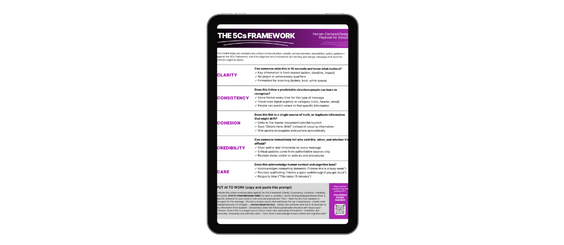02: Why Your Staff Aren't Reading
(It's Not What You Think)
📺 Prefer video?
Watch this 6-minute version, or keep reading.
Where We Are
A curriculum coordinator told me last week:
“I write clear emails. I send meeting notes. I post updates on three different platforms. And still, someone says ‘I didn’t know about that’ every single week. It makes me feel like they don’t care.”
But what if they do care, and the problem isn’t whether people are reading, but whether what you’re writing matches how their minds actually work?
That’s not a people problem. That’s a systems problem.
Today, I want to share a tool that helps you design communication that works for different minds simultaneously.
The 5Cs Framework
The framework is called the 5Cs: Clarity, Consistency, Cohesion, Credibility, and Care.
Think of it as both a diagnostic tool—which C is missing when communication breaks down?—and a design checklist—does this meet all five before I send?
But before I show you how to use it, let me tell you why I created it.
Four Teachers, Same Emails, Four Different Minds
I asked four teacher friends the same simple question: “How did you know what you needed to know for your classes last week?”
What I discovered revealed a fundamental mismatch.
Teacher 1 reads every email thoroughly and cross-references the calendar weekly. She sees emails as documentation she can reference later.
Teacher 2 ignores most emails unless they’re urgent. He checks only when he needs specific information for immediate action. Long emails feel like busywork.
Teacher 3 doesn’t trust written information until she’s heard it in conversation. She waits for faculty meetings to understand the “why” behind decisions.
Teacher 4 checks email twice daily and ignores anything not directly relevant to her classroom. She calls it “survival, not laziness.”
Same school. Same emails. Four completely different cognitive approaches.
Here’s the problem: your comprehensive weekly update serves Teacher 1 perfectly—but actively harms Teacher 4. Your brief reminders support Teacher 2 and leave Teacher 3 feeling disconnected.
You can, however, design for cognitive diversity.
How the 5Cs Work in Practice
Let’s walk through each of the 5Cs using real examples:
Clarity
Can someone skim this in 10 seconds?
Instead of
“Dear Families, Please be advised that students will need to arrive with appropriate materials for the upcoming field trip as outlined in the previous communication.”
Go for:
“For Friday’s field trip: Lunch, water bottle, permission slip.”
Consistency
Does it follow a predictable structure and format?
Here’s an example of a simple, clear path:
Title: Schedule Change
What Changed: Science Fair moved
When: Changed to November 15th
What to do: Mark your calendar
Cohesion
Does it link to a single source or duplicate information?
As the last post suggested, you establish a Single Source of Truth: one master calendar—ideally the website or student information system. All other documents pull directly from this source or link to it.
When the Science Fair date changes, it updates in ONE place. Everything else points there.
Credibility
Are authority and timestamp clear?
When a change is announced, the communication should explicitly state who’s sending it, when, and where to verify.
Emergency updates always come from the principal’s official channel. Routine updates have clear authorship and timestamps visible.
This removes all doubt about what’s official and what’s current, and builds trust.
Care
Does it acknowledge human context?
Instead of
“All staff must complete training by Friday,”
Go for:
“I know this is a busy week. The 15-minute training is due Friday. Here’s a quick walkthrough if you get stuck.”
Put AI to Work
If you’re thinking, “I don’t have time to redesign every communication,” this is where AI tools can help you.
You can paste one of your regular communications into a tool like ChatGPT or Claude and say: “Audit this using the 5Cs Framework. Rank Cs by strongest to weakest.”
To help, I’ve created a free 5Cs Communication Toolkit with an audit checklist you can print and keep at your desk, as well as AI prompts you can copy and paste to revise your messages for cognitive diversity.
Alternatively, you can use this custom GPT, which has been trained on the 5Cs context: 🤖 Your School Comms Assistant
This Week’s Move
Pick one regular communication—your weekly update, a recurring announcement, a standard form—and spend just 15 minutes running it through the 5Cs.
Fix the weakest C before you hit send next time.
Let’s stop assuming everyone’s mind works like ours and start building communication systems that work for different cognitive patterns.
Your Experience
Have you noticed patterns in who engages with different types of communication? Hit reply and tell me what you’re seeing.
Systematically yours,
About the Author:
G (short for Gitane) is co-founder and Chief Creative Officer at EKG Collective, helping international schools turn communication complexity into systematic clarity. Learn more at ekgcollective.com.





Very helpful! Practical advice that I’m not seeing anywhere else. Thank you!